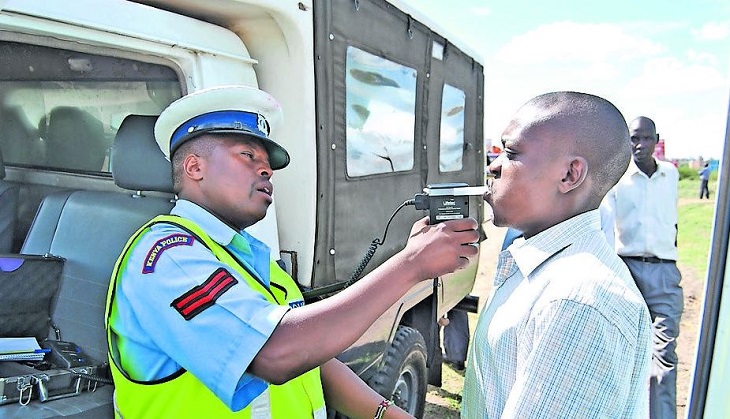In Kenya, road safety remains a critical concern, with drunk driving being a leading cause of fatal accidents. The National Transport and Safety Authority (NTSA) has implemented stringent regulations to curb this menace, particularly through enforcing maximum alcohol limits for drivers. These laws aim to protect lives, reduce accidents, and ensure safer roads for all Kenyans. This comprehensive guide explores Kenya’s alcohol limits for drivers in 2025, the legal framework, testing methods, penalties, and practical tips for compliance, with a focus on public service vehicles (PSVs), commercial vehicles, school transport vehicles, and private drivers.
Understanding Kenya’s Alcohol Limits for Drivers
Kenya’s road safety laws, enforced under the Traffic Act and overseen by the NTSA, set clear alcohol limits for drivers based on vehicle type. These regulations are designed to address the varying levels of responsibility borne by drivers of different vehicle categories, such as PSVs, commercial vehicles, school transport vehicles, and private vehicles. The legal limits for alcohol consumption while driving are strictly defined to ensure public safety.
Alcohol Limits for Public Service, Commercial, and School Transport Vehicles
Drivers of public service vehicles (PSVs), commercial vehicles, and school transport vehicles face a zero-tolerance policy for alcohol consumption. This strict standard reflects the high level of responsibility these drivers carry, as they transport passengers, goods, or vulnerable schoolchildren. The legal limits are:
- 0 micrograms of alcohol per 100 milliliters of breath
- 0 micrograms of alcohol per 100 milliliters of blood
- 0 micrograms of alcohol per 100 milliliters of urine
This zero-tolerance policy means that any detectable alcohol in the system of these drivers is a violation, leading to severe penalties. The rationale is clear: these vehicles carry multiple passengers, and any impairment could result in catastrophic consequences. For example, a matatu driver operating a PSV or a school bus driver transporting children must maintain absolute sobriety to ensure safety.
Alcohol Limits for Private Drivers
For drivers of private vehicles, the alcohol limits are slightly more lenient but still strictly enforced to prevent impaired driving. The legal thresholds are:
- 45 micrograms of alcohol per 100 milliliters of breath
- 80 micrograms of alcohol per 100 milliliters of blood
- 107 micrograms of alcohol per 100 milliliters of urine
These limits align with international standards, such as those in many African countries where a blood alcohol content (BAC) of 0.08% is common, as noted in global drunk driving laws. This threshold allows for minimal alcohol consumption, equivalent to roughly one standard drink for most adults, but exceeding it can impair reaction times and judgment, posing significant risks on the road.
Why Kenya Enforces Strict Alcohol Limits
Drunk driving is a leading cause of road accidents in Kenya, contributing to thousands of injuries and fatalities annually. According to the NTSA, alcohol-related crashes account for a significant portion of the country’s road traffic accidents, with devastating impacts on families and communities. For instance, a tragic crash involving a school bus along the Kisumu-Kakamega Highway in 2025 highlighted the dangers of impaired driving, prompting renewed calls for stricter enforcement.
The zero-tolerance policy for PSV, commercial, and school transport drivers reflects the government’s commitment to protecting vulnerable road users. Meanwhile, the limits for private drivers aim to balance personal freedom with public safety, encouraging responsible drinking while deterring reckless behavior.
The Impact of Drunk Driving in Kenya
- High Accident Rates: Alcohol impairs coordination, reaction time, and decision-making, increasing the likelihood of collisions.
- Economic Costs: Road accidents cost Kenya billions of shillings annually in medical expenses, property damage, and lost productivity.
- Loss of Lives: Fatalities from drunk driving affect families, communities, and the nation’s social fabric.
- Legal Consequences: Violators face fines, imprisonment, and license suspension, impacting their livelihoods.
How Alcohol Levels Are Tested in Kenya
To enforce these alcohol limits, Kenyan authorities use a combination of breath, blood, and urine tests. These methods are designed to accurately measure alcohol levels in a driver’s system, ensuring compliance with the law.
Breath Tests
Breathalyzers are the most common tool used by Kenyan police to detect alcohol levels. These portable devices measure the concentration of alcohol in a driver’s breath, providing immediate results. The legal limits are:
- 0 micrograms per 100 ml for PSV, commercial, and school transport drivers.
- 45 micrograms per 100 ml for private drivers.
Police often conduct random roadside checks, especially during peak times like weekends or holidays, to catch violators. If a driver exceeds the limit or refuses to provide a breath sample, they may face immediate arrest and further testing.
Blood Tests
Blood tests are more invasive but highly accurate, measuring the exact alcohol content in a driver’s bloodstream. These tests are typically conducted at a police station or medical facility if a breath test indicates impairment or if the driver disputes the results. The limits are:
- 0 micrograms per 100 ml for PSV, commercial, and school transport drivers.
- 80 micrograms per 100 ml for private drivers (equivalent to 0.08% BAC).
Blood tests are often used in serious cases, such as accidents involving injuries or fatalities, to provide evidence for prosecution.
Urine Tests
Urine tests are less common but may be used in specific circumstances, such as when breath or blood tests are inconclusive. The limits are:
- 0 micrograms per 100 ml for PSV, commercial, and school transport drivers.
- 107 micrograms per 100 ml for private drivers.
Urine tests are typically conducted in controlled settings and are used to corroborate other test results.
Penalties for Violating Alcohol Limits in Kenya
Kenya’s Traffic Act and NTSA regulations impose harsh penalties for drivers who exceed the legal alcohol limits. These penalties aim to deter drunk driving and protect public safety.
Penalties for PSV, Commercial, and School Transport Drivers
Given the zero-tolerance policy, any detectable alcohol in these drivers’ systems triggers severe consequences:
- Fines: Up to KSh 100,000 or more, depending on the severity of the offense.
- Imprisonment: Up to 2 years for first-time offenders, with longer terms for repeat violations.
- License Suspension: Immediate suspension for at least 1 year, with potential permanent revocation.
- Vehicle Impoundment: The vehicle may be seized, especially for commercial or PSV operators.
- Mandatory Training: Offenders may be required to undergo road safety education programs.
Penalties for Private Drivers
Private drivers exceeding the 0.08% BAC limit face:
- Fines: Up to KSh 50,000 for first-time offenders.
- Imprisonment: Up to 6 months, with harsher penalties for repeat offenders or accidents causing harm.
- License Suspension: Suspension for 6 months to 1 year.
- Community Service: In some cases, offenders may be required to perform community service.
Additional Consequences
- Criminal Record: A drunk driving conviction can result in a permanent criminal record, affecting employment and travel.
- Insurance Issues: Insurance companies may deny claims or increase premiums for drivers with drunk driving convictions.
- Public Shaming: High-profile cases may be publicized, deterring future violations but impacting the offender’s reputation.
Kenya’s Road Safety Laws in 2025: Key Updates
In 2025, Kenya continues to strengthen its road safety framework, with a focus on drunk driving prevention. Recent updates include:
- Increased Roadside Checks: The NTSA has expanded random breathalyzer tests, particularly in urban areas like Nairobi, Mombasa, and Kisumu.
- Public Awareness Campaigns: Initiatives by the NTSA and organizations like the National Campaign Against Drug Abuse (NACADA) educate drivers on the dangers of drunk driving.
- Stricter Penalties: Proposals to increase fines and imprisonment terms for serial offenders are under consideration, aligning with regional trends.
- Technology Integration: Advanced breathalyzers and data-driven enforcement strategies are being adopted to improve accuracy and efficiency.
Practical Tips for Kenyan Drivers to Stay Compliant
To avoid violating Kenya’s alcohol limits and ensure road safety, drivers can follow these practical steps:
- Plan Ahead: If you plan to drink, designate a sober driver or use a ride-hailing service like Uber or Bolt.
- Understand Your Limits: For private drivers, stick to minimal alcohol consumption (e.g., one beer or glass of wine) and wait at least an hour before driving.
- Stay Sober for Work: PSV, commercial, and school transport drivers must abstain from alcohol entirely before and during work hours.
- Know the Testing Process: Familiarize yourself with breath, blood, and urine tests to understand what to expect during roadside checks.
- Support Awareness Campaigns: Participate in NTSA or NACADA programs to promote sober driving in your community.
The Role of Public Awareness in Reducing Drunk Driving
Public awareness is critical to reducing drunk driving in Kenya. Organizations like NACADA and the NTSA run campaigns to educate drivers about the risks of alcohol-impaired driving. For example, NACADA has emphasized data-driven prevention strategies to protect young Kenyans from substance abuse-related accidents. Additionally, high-profile figures, including government officials, have called for stricter measures, such as raising the legal drinking age to 21, to curb alcohol-related road incidents.
Community Initiatives
- Sober Driving Pledges: Community groups encourage drivers to pledge sobriety, especially during festive seasons.
- School Programs: Schools educate students about road safety and the dangers of drunk driving.
- Media Campaigns: Radio, TV, and social media platforms like X promote messages like “Don’t Drink and Drive.”
Comparing Kenya’s Alcohol Limits to Global Standards
Kenya’s alcohol limits align with many African and global standards but are stricter for PSV, commercial, and school transport drivers. For comparison:
- South Africa: 0.05% BAC for private drivers, 0.02% for professional drivers.
- Canada: Varies by province, typically 0.04–0.08% BAC.
- Brazil: Zero tolerance for all drivers, with fines and license suspension for any detectable alcohol.
- United Kingdom: 35 micrograms per 100 ml of breath, similar to Kenya’s private driver limit.
Kenya’s zero-tolerance policy for certain drivers is among the strictest, reflecting the country’s commitment to protecting passengers and pedestrians.
Challenges in Enforcing Alcohol Limits
Despite robust laws, enforcement faces challenges:
- Corruption: Some drivers attempt to bribe officers to avoid penalties, undermining enforcement efforts.
- Resource Constraints: Limited breathalyzers and trained personnel can hinder roadside testing.
- Public Resistance: Proposals like raising the drinking age to 21 have sparked debate, with critics arguing it contradicts constitutional rights for 18-year-olds.
- Illicit Alcohol: The prevalence of cheap, unregulated alcohol contributes to drunk driving, as noted in discussions about Kenya’s alcohol taxation policies.
The Way Forward: A Safer Kenya on the Roads
Kenya’s alcohol limits for drivers are a cornerstone of its road safety strategy, reflecting a commitment to reducing accidents and saving lives. By enforcing zero-tolerance for PSV, commercial, and school transport drivers and strict limits for private drivers, the NTSA aims to create a culture of responsible driving. However, sustained progress requires:
- Enhanced Enforcement: More breathalyzers, trained officers, and random checks.
- Public Education: Continued campaigns to promote sober driving and responsible alcohol consumption.
- Policy Reforms: Addressing gaps in enforcement and tackling illicit alcohol markets.
- Community Engagement: Encouraging Kenyans to report drunk driving and support safety initiatives.
By working together, drivers, authorities, and communities can make Kenya’s roads safer for everyone.
Kenya’s alcohol limits for drivers are a vital tool in the fight against drunk driving, with clear distinctions between PSV, commercial, school transport, and private drivers. The zero-tolerance policy for professional drivers and strict thresholds for private drivers underscore the government’s commitment to road safety. By understanding these limits, complying with testing protocols, and supporting awareness campaigns, Kenyans can contribute to safer roads and a brighter future. Stay sober, stay safe, and let’s drive towards a crash-free Kenya in 2025 and beyond.





